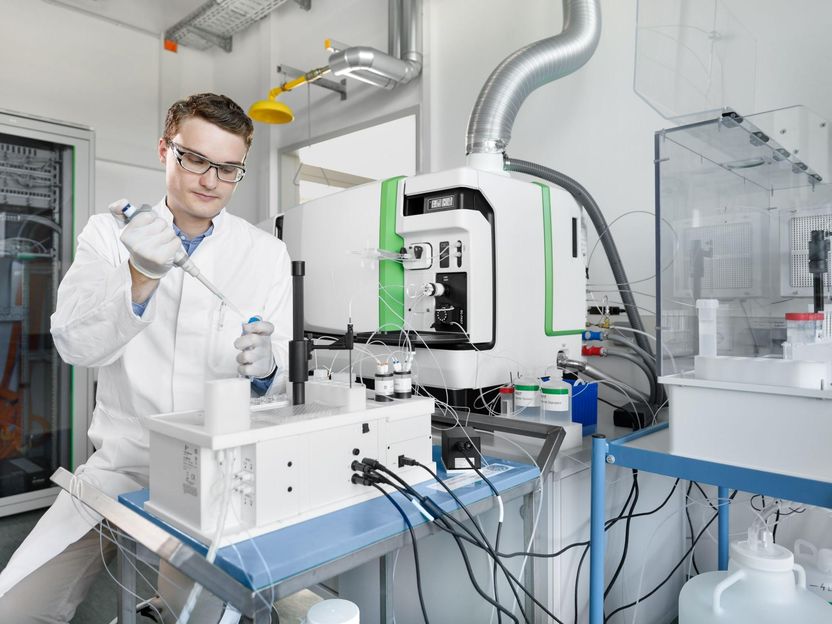Microplastics change the intestinal flora of seabirds
New research approach combines microplastics and microbiome research
The more microplastics in the intestines of seabirds, the more the microbial diversity changes, with the result that beneficial bacteria decrease and pathogens, as well as antibiotic-resistant and plastic-degrading microbes increase. This is the result of a study on the intestinal microbiome of wild birds. The investigation by researchers from Ulm University together with partners from Portugal and Canada was published in the scientific journal Nature Ecology & Evolution.

Symbolic image
Computer-generated image
Microplastic pollution of the environment is a highly topical problem. Microplastics are plastic particles that are smaller than 5 millimetres. This plastic - often formed by the fragmentation of larger pieces of plastic - is now popping up everywhere. Microplastics have even been detected in the deep sea and in remote areas such as Antarctica. There are few effective measures to systematically curb or combat microplastic pollution on a global scale. "This is probably because there is currently little evidence that the amounts of microplastics already present in the environment have a negative impact on the health of affected species," explains first author Gloria Fackelmann, who conducted this study as part of her doctoral thesis at the Institute of Evolutionary Ecology and Conservation Genomics at Ulm University, Germany.
In their study, the scientists examined the gut microbiome of two seabird species, the northern fulmar (Fulmarus glacialis) and the Cory's shearwater (Calonectris borealis). Both species live mainly on the high seas and feed on marine molluscs, crustaceans and fish. In addition, both species migrate thousands of kilometres over the course of the year, allowing global conclusions to be drawn.
In the study, the researchers characterized the intestinal microbiome of 85 seabirds using high-throughput sequencing. The microplastics filtered from the gastrointestinal tract of the dissected seabirds through a 1 mm sieve were examined under a light microscope and characterized using a standard protocol for seabirds.
Microplastic ingestion changes microbial communities throughout the gastrointestinal tract of both seabird species. The amount of microplastics in the gut correlates significantly with the microbial diversity and composition of the gut bacterial community: microplastics were associated with a decrease in commensal bacteria and an increase in pathogenic (zoonotic), antibiotic-resistant, and plastic-degrading microbes.
The scientists place a special focus on the gut microbiome as an indicator of health and as a key component of the immunity and well-being of the host animal. The more microplastics found in the gut, the fewer commensal bacteria could be detected. Commensal bacteria perform essential functions in the body that go far beyond digestion and nutrient metabolism, and play a central role in, for example, immune modulation and protection against pathogens. Disturbances may impair many health-related processes and may lead to host diseases.
The exact mechanisms behind the effects of microplastics on the gut microbiome of wild animals are not known, but the researchers have already presented various possible scenarios. "In addition to the consequences of mechanical injuries, pathogens carried over with the microplastics or chemical disturbances caused by the plastic polymers could also come into question," explains Institute Director Professor Simone Sommer. The overarching goal of the researchers is to gain a better understanding of whether and how organisms whose diet is chronically contaminated with microplastics are affected.
The interdisciplinary approach between microplastic and microbiome research is innovative. So far, only a few pilot studies have been published, but laboratory results are often based on high concentrations of microplastics. These may not be representative of the concentrations observed in nature. However, the new study led by the Institute of Evolutionary Ecology and Conservation Genomics of Ulm University shows that changes in the microbiome already occur at microplastic concentrations that are present in the environment and are ingested by relevant species. "Our conclusions reflect the current situation in the wild. Since humans also uptake microplastics from the environment and through food, this study should act as a warning for us humans," say the authors of the study.

























































